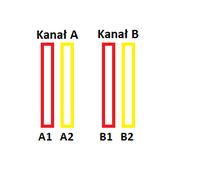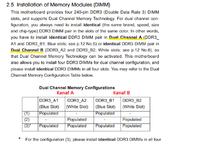This is how I read the internet about dual chanel (wikipedia and other websites and forums) and a certain thing is not fully explained and I write it differently. He writes to put identical memories in the same colors, but this is not what he wants to ask.
Q1.
We have a motherboard, it has 4 slots: 2 red (A1, B1) and 2 yellow (A2, B2). As I mentioned earlier, they write differently, but I understand it so that two slots of different colors form one channel, i.e. there are generally two channels:
-channel A (A1-red slot, A2- yellow slot)
-channel B (B1-red slot, B2- yellow slot)
and for the memories to work in dual, you have to put one dice into each channel.

Do I understand correctly ??
Q2. If I understand question 1 correctly, question 2 is relevant.
It says on the CDs that in order for there to be a two-channel mode, the memory must be inserted into the slots of the same colors A1zB1 or A2zB2.
Since one channel has two slots, what difference do we put in the memory. In my opinion, A1 with B2 or A2 with B1 should also work in dual because there is one memory in each channel.
Q3 If we put in 3 memory dice (eg 2 memories channel A and 1 memory channel B) then we will not have dual but we will have the sum of all three memory dice. I understand well ??
Q1.
We have a motherboard, it has 4 slots: 2 red (A1, B1) and 2 yellow (A2, B2). As I mentioned earlier, they write differently, but I understand it so that two slots of different colors form one channel, i.e. there are generally two channels:
-channel A (A1-red slot, A2- yellow slot)
-channel B (B1-red slot, B2- yellow slot)
and for the memories to work in dual, you have to put one dice into each channel.

Do I understand correctly ??
Q2. If I understand question 1 correctly, question 2 is relevant.
It says on the CDs that in order for there to be a two-channel mode, the memory must be inserted into the slots of the same colors A1zB1 or A2zB2.
Since one channel has two slots, what difference do we put in the memory. In my opinion, A1 with B2 or A2 with B1 should also work in dual because there is one memory in each channel.
Q3 If we put in 3 memory dice (eg 2 memories channel A and 1 memory channel B) then we will not have dual but we will have the sum of all three memory dice. I understand well ??



